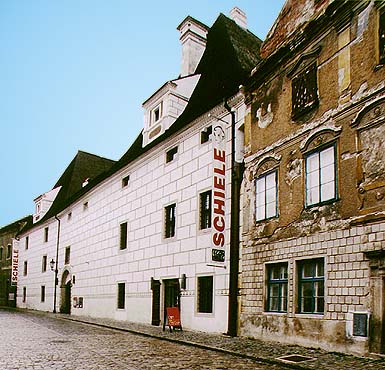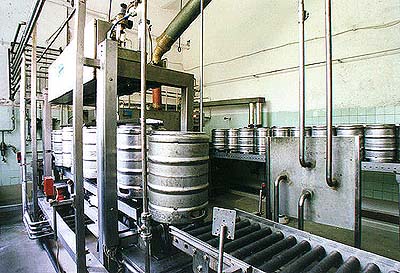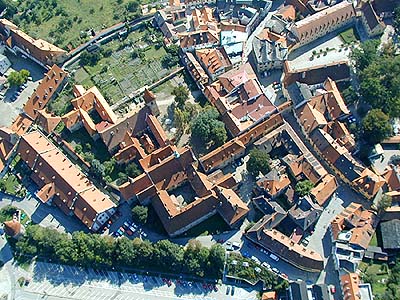History of Brewing in Český Krumlov
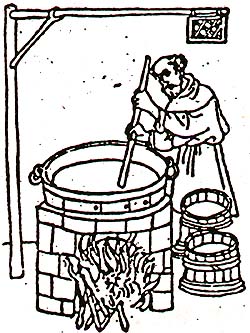 Brewing beer for royal consumption in Český Krumlov could have been assumed since the castle's foundation in 13th century. The brewery and malt-house used to stand in the IV. castle yard in front of Plášťový (Cloak bridge facing the town until 1560. Besides barley and wheat malt beer, thin beer for minorites, servants, working serfs and others was brewed there as well.
Brewing beer for royal consumption in Český Krumlov could have been assumed since the castle's foundation in 13th century. The brewery and malt-house used to stand in the IV. castle yard in front of Plášťový (Cloak bridge facing the town until 1560. Besides barley and wheat malt beer, thin beer for minorites, servants, working serfs and others was brewed there as well.
Beer has been brewed in Krumlov undoubtedly since the 14th century. In 1347, Peter I. von Rosenberg granted the town a "mile law" to establish pubs and a brewery, and by 1388 the sovereign allowed the burghers to sell beer too. There was a dispute in 1459 between Latrán quarter residents and town burgher on brewing rights; Latrán residents won. Wheat malt beer production was exclusively carried out by Krumlov burghers in1503 while barley malt beer could have been brewed by residents of both quarters. The situation remained unchanged even after the Latrán quarter became a part of the town in 1555. In 1605 the municipal council had a new burghers' brewery built on Široká street ( Široká no. 71). Burghers kept on brewing barley malt beer in the old brewery, and in 1643 bought the whole factory.
In 16th century, the sovereign's brewery became insufficient due to increasing beer production. Wilhelm von Rosenberg thus had a new building erected in 1560 which was connected with a new water works built by Jakub Krčín of Jelčany in 1561 (see History of Waterworks in Český Krumlov). Both barley and wheat beer were produced there; however, the old brewery was still in operation as well.
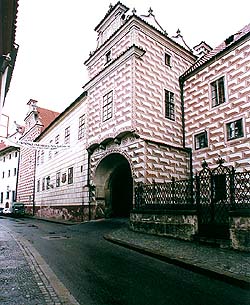 In 1600, the total net revenue of the old castle brewery was 300 three-scores of Meissen groses and the new one produced 3.300 three-scores of Meissen groses. Beer consumption and therefore space demands were gradually increasing. During 1625 - 1630, the former widow residence of Anna von Rogendorf, mother of Wilhelm von Rosenberg, from 1546, and an arsenal of Peter Wok von Rosenberg from 1594 - 1596 were rebuilt into a new brewery where the current Eggenberg brewery had its main place of business ( Latrán No. 27).
In 1600, the total net revenue of the old castle brewery was 300 three-scores of Meissen groses and the new one produced 3.300 three-scores of Meissen groses. Beer consumption and therefore space demands were gradually increasing. During 1625 - 1630, the former widow residence of Anna von Rogendorf, mother of Wilhelm von Rosenberg, from 1546, and an arsenal of Peter Wok von Rosenberg from 1594 - 1596 were rebuilt into a new brewery where the current Eggenberg brewery had its main place of business ( Latrán No. 27).
Another brewery owned by the Archdeanery which had been licensed to produce beer by the Rosenbergs was founded in 16th century. However, under the emperor's administration in 1602 it was curtailed and later on vanished entirely. The Prelature ( Horní No. 155) was given its brewing right back during the Eggenberg's rule.
In the course of 19th century, the Clarisse brewery closed down approximately in 1782 while the others were still in full operation. The owner of the Castle brewery changed in 1719 when the brewery became the Schwarzenbergs' property. During 1782 - 1865, the Prelature brewery was rented by the town hall. Burghers had great arguments over the Town brewery which ended up with success for 201 burghers possessing brewing right.
Following is a comparison of four town breweries production during 18th century:
| Brewery | Volume of beer (hl) | Average annual production during1710 - 1712 (hl) |
| Clarisse Brewery | 29,8 | 58 |
| Archdeanery and Prelature Brewery | 24,8 | 844 |
| Eggenberg Brewery | 79,4 | 7.400 |
| Town Brewery | 105,4 | 6.070 |
Before 1700, the Castle brewery usually produced barley (dark) and wheat (light) beer which were called "patoky", thin beer and beer determined for reapers. Wheat beer prevailed in 1800, and barley beer production was terminated. Hops were grown in hop-gardens around the town until 1788 (Kvítkův dvůr, Vlaštovičník, Nový Dvůr, Dobrkovice, Křenov and Červený Dvůr). After they closed down, good-quality hops had to imported from the Schwarzenbergs' manors in northern Bohemia. In 1837, the Manor brewery started to produce beer by means of a bottom fermentation process, however, the upper fermentation method still prevailed in rate of 3.840 to 903 barrels in 1850. In the course of the 18th and the first half of the 19th century, the brewery underwent numerous construction arrangements and changes and was one of the biggest breweries within the Schwarzenbergs' property. In 1852, the Brewery administration founded an English malt-kiln and, five year later, a new brew-house. 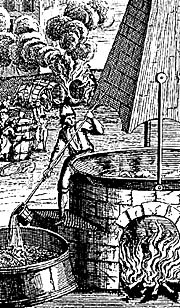 Half of the brewery was seriously damaged during a fire in 1869 and was renovated in 1870. During 1867 - 1870 new cellars with a top refrigerator were built. The whole operation became steam-driven and started to use modern machinery equipment. There were 14 full-time employees working at the end of the 1860's. Their number increased up to 32 during 1875 - 1885. The Schwarzenberg brewery production kept on increasing until the WWI. (in 1862/63 - 12.359 hectoliters, in 1871/72 - 22.069 hl, in 1879/80 - 24.840 hl, in 1884/85 - 30.200 hl, in 1895/96 - 34.500 hl, in 1910/11 - 34.820 hl and in 1913/14 - 31.904 hl of beer).
Half of the brewery was seriously damaged during a fire in 1869 and was renovated in 1870. During 1867 - 1870 new cellars with a top refrigerator were built. The whole operation became steam-driven and started to use modern machinery equipment. There were 14 full-time employees working at the end of the 1860's. Their number increased up to 32 during 1875 - 1885. The Schwarzenberg brewery production kept on increasing until the WWI. (in 1862/63 - 12.359 hectoliters, in 1871/72 - 22.069 hl, in 1879/80 - 24.840 hl, in 1884/85 - 30.200 hl, in 1895/96 - 34.500 hl, in 1910/11 - 34.820 hl and in 1913/14 - 31.904 hl of beer).
The second half of the 19th century was just an epilogue for the Prelature brewery. It managed to brew 3.168 hectoliters of beer only in 1865, 2 040 hl in 1880, 1.500 hl. in 1885 and 2.300 hl in 1895. Three full-time employees worked there only at the end of sixties, and only one joined them during the period of 1875 - 1885. In 1865 the brewery was rented by the municipal council and returned to prelature's administration soon again. Its operation terminated in 1897.
Burghers and Town brewery competed to the Schwarzenbergs' brewery even in the course of the industrial revolution. It produced 7.322 hl of beer in 1865 , 7.848 hl of beer in 1880, 10.400 hls of beer in 1885, 18.282 hls of beer in 1898 and 18.040 hls of beer in 1901. Ten full-time employees worked there at the sixties, and their number increased up to 13 during the period of 1875 - 1885. In 1898, it became steam-driven and further updating of machinery equipment started. However, in terms of further development and production volume it remained little behind the Schwarzenberg competitor.
After the Munich negotiations in 1938 when Český Krumlov became a part of the German protectorate, the Schwarzenberg brewery operated in a newly reconstructed space with two steam boilers covering 120 m2 and one 75 hP steam-driven machine-room and a 57 kW dynamo. Further it utilized a 100 hls brewing kettle from 1915, a draff dryer, ice crusher and ice elevator. The malt-house was newly equipped with modern machinery during the economy period of 1927/28. Its equipment included 7 pubs and 4 warehouses to supply its regional outlets. 1 car, 3 trucks and 1 beer cistern provided the transportation. Production of the brewery, however, seldom reached the same level it used to have before WWI. but rather lower. The brewery itself was worth over 6 million of CZK in 1929 and its net revenue was 855 577 of CZK.
During the First Republic and period of Nazi occupation, the Town directional brewery in Česky Krumlov which was owned similarly by the town and by the brewing-licensed burghers possessed an ancient malt-house, a beautiful modern copper brewing kettle produced by 1. Brnenska Machine Works and an efficient machine room with a steam machine and a dynamo. Cooling drains were replaced by a modern sediment tub and the fermentation section had many concrete tubs available as well. Annual brewery production varied from 4.000 up to 19.353 hls of beer which was practically little less then in the Schwarzenberg brewery. Its production was fully restored after the Czech Republic's liberation in 1945, but it closed down completely in January of 1949.
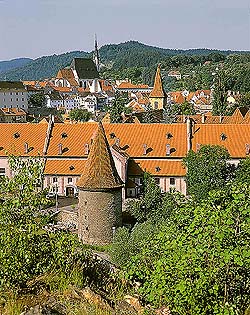 According to a President's order from May 19th, 1945, the Provincial National Council in Prague imposed a national administration on the whole of the Schwarzenbergs' property. Obviously this involved the Schwarzenberg brewery in Česky Krumlov as well. Furthermore, according to a code from July 10,1947 (so-called Lex Schwarzenberg), it became the property of the Czech Republic. Later it was included into a new organization network of government estates and by 1949 became state property. From January 1 of 1950, it was a part of the regional brewing works network (Jihočeské pivovary, n. p., České Budějovice, then named Pivovary České Budějovice, s. p.). In September 7, 1991, the owner changed again and the brewery was sold out by means of small privatization to Dionex Český Krumlov, Ltd., owned by František Mrázek and Jiří Shrbený, for 75 thousand CZK. The company's name was changed in March 1, 1993, to Pivovar Eggenberg, a. s., Český Krumlov.
According to a President's order from May 19th, 1945, the Provincial National Council in Prague imposed a national administration on the whole of the Schwarzenbergs' property. Obviously this involved the Schwarzenberg brewery in Česky Krumlov as well. Furthermore, according to a code from July 10,1947 (so-called Lex Schwarzenberg), it became the property of the Czech Republic. Later it was included into a new organization network of government estates and by 1949 became state property. From January 1 of 1950, it was a part of the regional brewing works network (Jihočeské pivovary, n. p., České Budějovice, then named Pivovary České Budějovice, s. p.). In September 7, 1991, the owner changed again and the brewery was sold out by means of small privatization to Dionex Český Krumlov, Ltd., owned by František Mrázek and Jiří Shrbený, for 75 thousand CZK. The company's name was changed in March 1, 1993, to Pivovar Eggenberg, a. s., Český Krumlov.
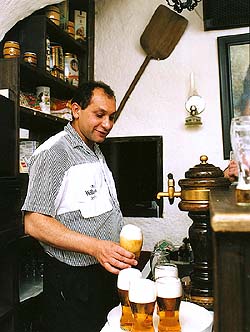 The current technical and production base of Jihočeské pivovary (South-Bohemian Breweries) and then its successor Pivovary České Budějovice, was changing slowly but significantly during the period of socialism. For example, a bottle decantation room was changed more than three times. Wooden tubs in the fermentation room were consequently replaced by ferroconcrete ones during 1960 - 1971. All the lager cellar sections containing wooden barrels were tanked so that the fermentation capacity increased up to 13.500 hls. Both filtration and cooling were modernized as well. The boiler room became gas-driven in 1979 - 1981. Washing and barrel drawing rooms equipment improved and a new water treatment room was built up which considerably affected the beer's quality. In 1983, malt production was terminated and malt was purchased from commercial malt-houses. More technical arrangements then followed. Construction condition of the operational buildings improved and reconstruction of the historical Rennaisance facades started which adds special value to such an important historical monument. All those changes resulted in increased beer production which increased more than four times from 1950 (31.062 hls) until 1990 (133.699 hls). Product assortment improved as well during that development period (7% of both light and dark beer untill 1969, dark 10% beer until 1969 and light beer in 1951 - 1991; Zámecké 11% light beer in 1973 - 1979 and Šumavský 12% lager in 1979 - 1991). Bottled beer sales consequently increased until it reached 62% of total production in 1990. Brewery sales were focused maily on the regions of Český Krumlov and Nové Hrady.
The current technical and production base of Jihočeské pivovary (South-Bohemian Breweries) and then its successor Pivovary České Budějovice, was changing slowly but significantly during the period of socialism. For example, a bottle decantation room was changed more than three times. Wooden tubs in the fermentation room were consequently replaced by ferroconcrete ones during 1960 - 1971. All the lager cellar sections containing wooden barrels were tanked so that the fermentation capacity increased up to 13.500 hls. Both filtration and cooling were modernized as well. The boiler room became gas-driven in 1979 - 1981. Washing and barrel drawing rooms equipment improved and a new water treatment room was built up which considerably affected the beer's quality. In 1983, malt production was terminated and malt was purchased from commercial malt-houses. More technical arrangements then followed. Construction condition of the operational buildings improved and reconstruction of the historical Rennaisance facades started which adds special value to such an important historical monument. All those changes resulted in increased beer production which increased more than four times from 1950 (31.062 hls) until 1990 (133.699 hls). Product assortment improved as well during that development period (7% of both light and dark beer untill 1969, dark 10% beer until 1969 and light beer in 1951 - 1991; Zámecké 11% light beer in 1973 - 1979 and Šumavský 12% lager in 1979 - 1991). Bottled beer sales consequently increased until it reached 62% of total production in 1990. Brewery sales were focused maily on the regions of Český Krumlov and Nové Hrady.
The Eggenberg brand name ( The Eggenbergs), which was taken from the noble family surname of the first historical owners and founders of that brewery, was symbolically accepted by the privatized brewery in Český Krumlov. Its current owners focus not only on brewing production development but to their own gastronomic and restaurant services, soft drinks sales and production, and some more intended activities. Besides having improved the semi-automatic gas boiler-room, they also bought a Danish Scandy-Brew yeast station, a Compair air compressor, 250 hls fermentation tank, a Swedish Sabroe cooling compressor, a Czech flow pasteurizer and a EK board filter. Having installed four 4000 hls CK tanks, the fermentaiton economy significantly improved and its capacity enlarged as well. The current brewing kettle's bottom was replaced for a steel one and the kettle operation was rearranged to semi-automatic. A drawing line for KEG barrels from a German company Gea Till (with capacity 60 fifty-liters barrels per hour) new case washer were installed and cooling towers were replaced and rearranged.
Avia trucks were replaced for foreign-made 3.5 tons ecologically operated trucks. Eggenberg, a.s. restored all the current historical building facades and opened its own restaurant with a pub, a wooden open-air restaurant and built a new gatehouse. Following is the semi-bitter and strongly fermented beer assortment produced by the brewery under the Eggenberg trademark: Dia beer (containes no sugar), light and dark 10% beer and light 12% lager (% indicates grade, not percentage of alcohol). The average annual production during the past seven years has been about 114.459 hls determined mainly for the regions of Česky Krumlov, outskirts of Lipno lake and Česky Brod. A small volume of beer is also exported to the former Yugoslavia, Italy, South Africa, Germany, Austria and Russia. Besides selling brewing remains, the clean brewing yeast is being sold in order to improve the brewery's economic situation. In addition to this, soft drink production includes six kinds of drinks with an average annual production of 3.000 hls.
(oš)


